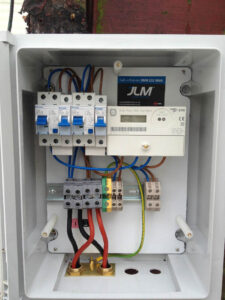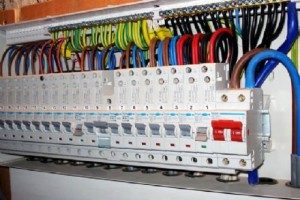In your home, it’s increasingly important to understand things like meter boxes, circuits and fuses, especially if for some reason your power or appliances cuts out. In Australia, the standard voltage of electricity entering a home is 230 volts. The electricity poles that you usually see on the street carry electricity into each home to a service point. A service point is where the power flows through to connect to your meter box.
Read below to find out more about how to identify how your power works!
The meter box
When electricity comes into a house its first stop is the meter box, you know the old metal box hanging on a wall or fence outside every home. The meter measures how many  units or Kilowatts (kWh) of electrical energy are used. From there the power then goes through the main switch which is where you can completely cut off your power in instances if you need repairs done or changes made to the wiring.
units or Kilowatts (kWh) of electrical energy are used. From there the power then goes through the main switch which is where you can completely cut off your power in instances if you need repairs done or changes made to the wiring.
Circuits
Every light and appliance is part of a circuit. A circuit is a path the electrical energy takes, it is made of an active wire that takes energy from the generator in your home to the appliance or light and a neutral wire that returns the electricity to the generator. When your appliance suddenly cuts off it’s usually because too much energy is being used in that one circuit, in order to reduce these overuse power points additional circuits are installed to reduce the risk of overloading which is generally caused by plugging too many appliances together in one circuit.
Switch board
After the electricity goes through the power poles and the meter box and before it goes through a circuit it first goes through a fuse board/switchboard. The fuse board has switches that branch the electricity to each appliance, light and powerpoint in the home creating the above-mentioned circuit. So in the fuse box, there is a fuse or switch for every circuit in your home (and it should be labelled as well). The fuses act as a safety for each circuit to protect the wiring in your home and also yourself. The wires for lights, appliances and more can only take so much electrical energy before they overheat. As said earlier the circuits in your home have a limit which is why you should ensure you have enough power points in your home or building. If your circuit does overheat, the fuse is what shuts off your lights, power or appliances, this ensures that no damage is done to the circuit and that it doesn’t overheat so much it causes an electrical fire.
If one of your fuses does blow (because a circuit is overheated) then you can determine what’s being overloaded by checking the fuse box and seeing which switch has been flipped. To get power flowing back through you just need to flip the switch again, but be sure that you have turned off or moved anything that may be causing the extra strain on the circuit.
Short circuits
The most common overloading that you may have heard of is short circuits or short-circuiting. This generally occurs when the insulation of the two wires (the plastic surrounding) has worn causing the two wires to touch. Another cause is if a bare active wire comes into contact with a metal component or appliance which is earthed. Before we talked about how every appliance has an active and neutral wire, but now more and more appliances have a third the ‘earth wire’ ( green and yellow). This is another form of protection if an appliance overloads the circuit.
An earth wire is connected to the body of an appliance and an earth stake, whenever a short circuit occurs in an appliance it should also increase the current of energy through the earth wire. In this case, the fault current melts the fuse or trips the circuit breaker causing the power to shut off. This generally only occurs if your appliance is faulty.
If you encounter any problems we always advise to get a fully licensed electrician to inspect your home or building because electricity is extremely dangerous if not handled properly. If you currently have an issue you can contact us to receive a quick quote from our friendly staff!

